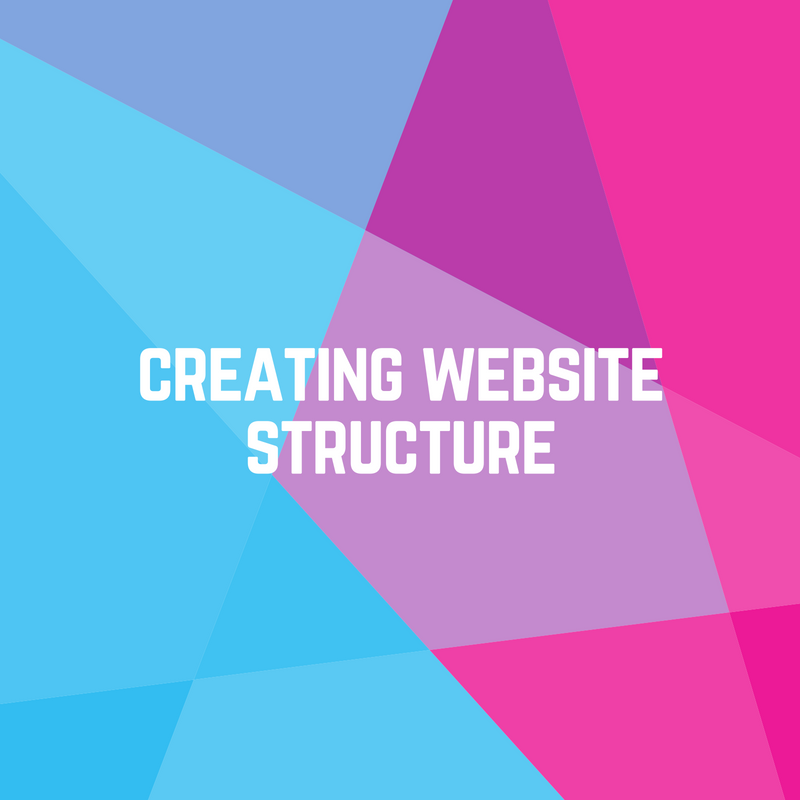
One of the challenges of creating your own website is starting with a good foundation or structure. Website structure defines things like how your pages will be ordered, which pages will appear in the navigation menu, the names of your pages, the styles you'll apply to elements, and other design choices.
The first thing you need to do is establish the primary goal of your website. Popular goals are to sell products, sell services, and convey inforamtion. There's a good chance your website will have more than one goal. For example you may want to provide educational materials about a product as well as actually sell the product from your website.
The best way to determine the type of information you should include on your website is to make a list of all the questions people ask you about your product, business, service, or organization. Once you have a list of all the questions you can begin to put them in an order of importance. The most important answers should be the things that are easiest to find on your website. While less important questions should require a little more digging. For example less important pages may be placed in submenus and are only revealed when they click a dropdown arrow.
With a list of questions and answers you should begin to get an idea of the most important things to communicate to site visitors. The most important thing should be conveyed somewhere near the top of the home page in the form of a headline or an iconic image. When a visitor comes to your website they'll give you about three seconds to figure out if they're at the right place. So the big theme of your website needs to be clear to them within that time frame.
When I create a list I usually come up with several things I think are important to communicate to people visiting the website. But I always try and determine the one things my site is really about and include that as a headline at the top of the home page. The remaining important points I typtically place further down the home page under icons or images that represent them. It turns out people don't read, they skim. In fact studies show people consume less of the information on your website when you overwhelm them with paragraphs of text when compared to providing them a few tidy bullet points surrounded by plenty of whitespace.
Once you've made the big points easy to find on your website it's time to start thinking about the flow of your website. That is, where you want people to go, and where you want them to end up. If you're selling a product you probably want to end up with a purchase of that product. Naturally providing visitors a clear route to do that is essential. However there are other things you should take into consideration. For example, people rarely make a purchase on their first visit to any website. So no matter how easy you make it to purchase your product there's a good chance they're not buying.
The way to combat the abandonment problem is to ask your site vistiors for a little information, like their email address. If you're able to get an email address or phone number from a visitor you can follow up with them. A lot of people won't even remember your web address, so following up is crucial to making a sell.
Asking site visitors for contact information is a little tricky. There's a good chance you're going to have to promise them something of value for them even to consider filling out your form. And remember the more information you ask for the greater that promise has to be. I recommend in most cases you start out by asking for very little, maybe only an email address. As for the promise it can be something simple like a coupon code for a discount, a free sample, a trial, a tip, a consultation.
It doesn't do any good to ask for an email address if you're never going to follow up. To make the follow up process easy enable your form to automatically place leads into your email marketing list. You can do this in WebStarts when creating a from. You can then enable the email marketing app and setup scheduled follow up emails and send broadcasts.
When you do your follow up by email it's important to direct your leads right back to where you want them in the flow of your website. If you're selling a product for example I recommend providing a link directly to where they can add that product to their cart. The easier you make it for people to find what they're looking for the more likely you are to achieve your desired outcome.
So far I've done a lot of talking about creating a website structure for selling products but it's really not different for conveying information. You can use the same principles to create a flow of information you want your visitors to get from your website.
If you are creating a website to primarily convey inforamtion you may want to consider adding a blog to it. Blogs are very much designed from the outset to convey inforamtion. In stead of making decisions about which things are most important you can simply make posts which can be search for by keyword or date. Adding a blog to a WebStarts website is as easy as clicking on the Blog app panel from the dashboard.